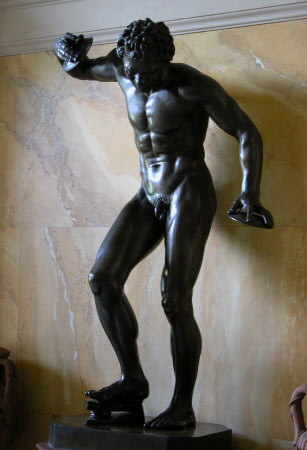Statue of the dancing faun
Sabatino de Angelis (b.1838)
Category
Art / Sculpture
Date
1890
Materials
Bronze
Measurements
1450 x 610 mm (57 1/8 x 24 in)
Place of origin
Naples
Order this imageCollection
Hatchlands Park, Surrey
NT 1166747
Summary
Sculpture, bronze; the Dancing Faun; Naples, foundry of Sabatino de Angelis (1838-c. 1915), after an antique marble; 1890. A full-size copy in bronze of the Dancing Faun, an antique marble sculpture that has long been one of the highlights of the Tribuna of the Uffizi. The copy was made in the Neapolitan manufactory of Sabatino de Angelis, one of the best of a number of Neapolitan sculptors in the later nineteenth and early twentieth centuries who set up bronze foundries to meet the demand for copies of famous antiquities, especially but not just those being discovered in Pompeii and Herculaneum. The group of five bronze casts at Hatchlands is an impressive representative example of this fashion in the decades around 1900.
Full description
A full-sized copy in bronze of the ancient marble known as the Dancing Faun, a figure of a naked male, identifiable as a faun from his pointed ears, small horns and tail. Holding a cymbal in each hand, he stands looking downwards towards his left foot, whilst his right foot is placed on a scabellum (a type of foot-operated castanet). The base, rectangular with canted edges and with the signature of the foundry and date, is cast separately. The antique marble statue known as the Dancing Faun probably entered the Medici collections in Florence around the mid-sixteenth century, although it is certainly recorded only in 1665. After its installation in 1688 in the Tribuna of the Uffizi, its merits became fully recognised, leading it to become one of the most admired of all Antique sculptures (Haskell and Penny 1981, no. 34). In the eighteenth century, at the height of the Grand Tour, it had an extraordinary reputation. The English painter and writer Jonathan Richardson for example thought it ‘the best in the Tribuna . . . ’tis so light,’tis leaping off its Pedestal’ (Richardson 1722, p. 57). The statue was much copied, especially in Florence by sculptors such as Massimiliano Soldani-Benzi, who made life-size versions in bronze for the Prince of Liechtenstein and the Duke of Marlborough, whilst his prolific workshop also produced smaller versions. The original sculpture is now recognised as a Hellenistic Greek marble statue, one figure in what was originally a two-figure ‘Invitation to the Dance’ group, the original version of which was made by the Greek sculptor Doidalas in the late third to early second century BC. The other statue in the group shows a seated nymph with her left leg resting on her right knee, in the act of putting on her sandal. The connection between the two sculptures has only been recognised in more modern times, so was not known before the mid-twentieth century. The bronze was cast not in Florence but in Naples, by Sabatino de Angelis (1838 – c. 1915), whose foundry was established in 1840, presumably by his father. It became, along with the Chiurazzi and Giorgio Sommer, one of the most successful and best-known of the Neapolitan foundries, which capitalised on the huge international demand in the later nineteenth century for high-quality copies of antiquities from Herculaneum, Pompeii, Rome and elsewhere, after the Italian government had in 1860 agreed to allow the making of copies of objects in the museum in Naples. All three foundries published catalogues of the products they offered, the 1900 catalogue from Sabatino de Angelis proudly proclaiming on its cover that the firm supplied casts to various European royal houses, as well as leading museums in London, Edinburgh, Glasgow, Boston, Chicago, New York and elsewhere. In the 1870s, Sabatino de Angelis also entered into a joint venture with the rival Chiurazzi foundry, forming the Fonderie Artistiche Riunite, the main purpose of which was to cater for the burgeoning American market. It also published a catalogue in 1910, largely based on the 1900 de Angelis catalogue, suggesting that it was this foundry that provided the majority of the models for the joint venture. It certainly appears to be the case that de Angelis was especially highly regarded internationally, the American curator Edward Robinson writing in 1892 that Sabatino De Angelis was ‘by far the best of the numerous Neapolitan copyists, his talent and feeling for his line of work being rare in any generation.’ (Edward Robinson, ‘Casts for the Metropolitan Museum of New York’, American Architect and Building News, 37 no. 872, 10 September 1892, pp. 166-68, p. 167). Although casts of the Dancing Faun are offered in both the 1900 de Angelis and 1910 Fonderie Artistiche Riunite catalogues, these are a different model from the Htachlands cast, in that they included a tree trunk attached to the faun’s left leg, as seen in the marble in the Uffizi. The five impressive casts at Hatchlands were probably all acquired by Harry Goodhart-Rendell’s grandfather Stuart Rendel, 1st Baron Rendel (1834-1913) to furnish the entrance hall at Hatchlands, after he had bought the house in 1888. Jeremy Warren May 2023
Provenance
Presumably acquired by Stuart Rendel, 1st Baron Rendel (1834-1913), c. 1890; by descent to Harry Stuart Goodhart-Rendel (1887-1959), by whom given in 1958.
Marks and inscriptions
Base:: Sabatino 1890 / Napoli
Makers and roles
Sabatino de Angelis (b.1838) , caster Sabatino de Angelis and Son, sculptor
References
Richardson 1722: Jonathan Richardson the Elder and Jonathan Richardson the Younger, An Account of some of the Statues, Bas-reliefs, Drawings and Pictures in Italy…, London 1722 Sabatino 1900: Catalogue illustré de Sab. De Angelis et fils, Naples, Naples 1900, p. 290 Chiurazzi and De Angelis 1910: Fonderie Artistiche Riunite. J. Chiurazzi & Fils – S. De Angelis & Fils. Bronzes, Marbres, Argenterie, Naples 1910, p. 79. Haskell and Penny 1981: Francis Haskell and Nicholas Penny, Taste and the Antique, The Lure of Classical Sculpture 1500 - 1900, New Haven and London, 1981, pp. 205-08, no. 34.

